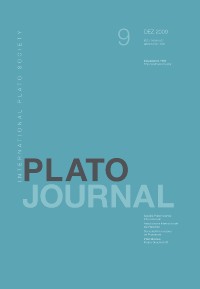Please use this identifier to cite or link to this item:
https://hdl.handle.net/10316.2/42200| Title: | Platon und die bildende Kunst: eine Revision | Authors: | Hub, Berthold | Issue Date: | 2009 | Publisher: | Imprensa da Universidade de Coimbra | Abstract: | Plato’s statements on art have met with countless commentators and almost as many different interpretations. In most cases, comments and hints that are scattered through various dialogues are taken out of context and played off against each other – depending on whether the intention is to portray Plato as a modern art lover or as an ageing political reactionary. In the face of the confusing range of contending opinions, there is an urgent need to examine and clarify the textual basis in Plato. For this purpose, a meticulous analysis of Book 10 of the Politeia is initially carried out – the only part of the corpus of Plato’s works that is concerned with art in detail and exclusively. The results are surprisingly clear. The corrupting and dangerous aspect of art is not attributed to individual artists or a specific artistic orientation, nor to the style of the depiction, nor to the content that is narrated or presented; instead, it is ascribed to its essential nature as the μίμησις of a μίμησις. Since even the objects of sense perception are imitations of the archetypal Ideas, which are ultimately accessible only to rational cognition, the artist is an imitator of something imitated. He merely touches on the (subjective) appearance of a reality that is in turn already a defective, mutable and ephemeral imitation of the only true, immutable and eternal archetypal Ideas. As the imitation of an imitation, art is insurmountably distant from truth and knowledge, ontologically and therefore also epistemologically worthless and useless – and also damaging, because it attempts to shackle us and domesticate us at a level three steps below truth. However, it not only holds us captive, but also corrupts us even further by appealing not to reason, but to the lower part of the soul with its desires and affections. It is because of this that it is corrupting and dangerous, initially for the individual character and individual spiritual welfare, and ultimately – through the individual – also for human society as a whole. Art thus creates precisely the situation which for the philosopher represents the fundamentally distorted condition from which he is attempting to liberate people. Art is constantly re-fastening the shackles that the philosopher releases. This is why art has to be excluded from Plato’s ideal state, with philosophy alone taking its place. The condemnation of all forms of art could not be expressed more clearly. Despite this, repeated efforts have been made to weaken the condemnation or even disprove its existence, either in order to save art from Plato or, conversely, to save Plato from condemning art. To achieve this, alleged contradictions between Books 10 and 3 of the Politeia have been pointed out (1); a differentiation or alteration in Plato’s understanding of the concept of μίμησις has been postulated; and reference has been made to passages in Plato’s works in which, it is claimed, the philosopher concedes that art has direct access to the world of the Ideas (2) or in which he speaks of the artist’s divine inspiration (3), as well as the numerous passages that discuss Beauty (4). Finally, it is claimed that Plato did not condemn all art, but only a certain contemporary trend in art (5, 6), or more generally, only illusionistic art in contrast to an abstract form of art (7) – namely Egyptian art (8). In the second part of the study, these lines of argumentation are discussed individually and in detail and their content is tested. In each case, the findings obtained initially in the analysis of Book 10 of the Politeia are confirmed. The present study does not offer any new hypotheses; instead, its goal is to use a detailed and differentiated examination of the relevant texts to clearly distinguish Plato’s view of art from later neo-Platonic views, as well as from obfuscations created by modern interpreters, in order to obtain a secure basis for future investigations of Plato’s view of art in particular, as well as of ancient aesthetics in general. The extensive review of the secondary literature also documents part of the history of twentieth-century scholarship. | URI: | https://hdl.handle.net/10316.2/42200 | ISSN: | 2079-7567 2183-4105 (PDF) |
DOI: | 10.14195/2183-4105_9_2 | Rights: | open access |
| Appears in Collections: | Plato Journal |
Files in This Item:
| File | Description | Size | Format | |
|---|---|---|---|---|
| platon_und_die_bildende_kunst.pdf | 1.59 MB | Adobe PDF |  |
Items in DSpace are protected by copyright, with all rights reserved, unless otherwise indicated.
